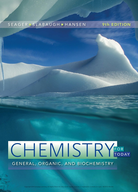Solution Found!
Glassware Drying with Acetone: The Science Behind It
Chapter 14, Problem 14.14(choose chapter or problem)
Questions & Answers
QUESTION: Most of the remaining water in washed laboratory glassware can be removed by rinsing the glassware with acetone (propanone). Explain how this process works (acetone is much more volatile than water).
ANSWER:Step 1 of 4
Acetone is a three-carbon-long ketone; therefore, it is the smallest member of the ketone family. It is an organic solvent used to conduct various chemical laboratory synthesis reactions.
Watch The Answer!
Glassware Drying with Acetone: The Science Behind It
Want To Learn More? To watch the entire video and ALL of the videos in the series:
This discussion delves into the use of acetone as a solvent for removing water from laboratory glassware, exploring the science behind its effectiveness and the role of hydrogen bonding in facilitating rapid evaporation.
